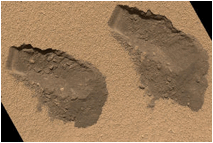Friday, September 27, 2013
Water for future Mars astronauts?
Two areas on Mars at “Rocknest” that were scooped out by the Curiosity Rover last year. JPL photo.
Within its first three months on Mars, NASA’s Curiosity Rover saw a surprising diversity of soils and sediments along a half-kilometer route that tell a complex story about the gradual desiccation of the Red Planet.
Perhaps most notable among findings from the ChemCam team is that all of the dust and fine soil contains small amounts of water.
“We made this discovery literally with the very first laser shot on the Red Planet,” said Roger Wiens, leader of the ChemCam instrument team. “Every single time we shot at dust we saw a significant hydrogen peak.” (Full Story)
Fusion, anyone? Not quite yet, but researchers show just how close we’ve come
The National Ignition Facility. From LLNL.
The dream of igniting a self-sustained fusion reaction with high yields of energy, a feat likened to creating a miniature star on Earth, is getting closer to becoming reality, according the authors of a new review article in the journal Physics of Plasmas.
The project is a multi-institutional effort including partners from the University of Rochester, General Atomics, Los Alamos National Laboratory, Sandia National Laboratory, and the Massachusetts Institute of Technology. (Full Story)
Event aims to humanize science to lure girls
Ellen Cerreta. LNAL photo.
Ellen Cerreta, a deputy group leader in the Materials Science and Technology Division at Los Alamos National Laboratory, is among the women in science who will conduct workshops for girls in grades five through eight to help expose them to the possibilities of careers in STEM-C (science, technology, engineering, mathematics and computing).
Citing the presence of the national labs in New Mexico, Cerreta said, “There is a tremendous amount of opportunity… for women in this state if they pursue careers in the STEM fields.” (Full Story)
Sandia Biotech gets global distribution and marketing agreement
Sandia Biotech, Inc. has signed a global distribution agreement with Sigma-Aldrich for its Split Fluorescent Protein product line, which is based on technology licensed from Los Alamos National Laboratory.
Sandia Biotech’s sFP technology, which includes several easy-to-use kits that are available in green, yellow and cyan variations, is utilized in protein and peptide analysis by the pharmaceutical drug development and industrial biotech communities. (Full Story)
Photos: 50 years of space
From left to right, Sam Bame, Dick Belian, Jack Fuller, Norm Blocker and Sid Singer at the Bradbury. LANL photo.
Present and former scientists and researchers who worked in LANL’s Vela satellite program commemorate 50 years of Los Alamos National Laboratory treaty verification from space at the Bradbury Science Museum.
In addition to a special Vela-shaped cake, participants enjoyed a presentation by lab associate Morrie Pongratz, who recounted 50 years of contributions to space research and national security programs. (Full Story)
Los Alamos picks three companies for remediation work
Road work at Los Alamos. LANL photo.
Los Alamos National Laboratory has selected three businesses for environmental support services work worth up to $400 million over a five-year period.
The businesses were selected based on a technical proficiency and lowest price basis. The companies — Terranear PMC, Navarro Research and Engineering, Inc. and Portage, Inc. — were chosen from 11 prospective bidders, according to a news release issued by the laboratory. Task orders under this agreement will be awarded based on available funding. (Full Story)
LANL reports damage to monitoring stations
Mortandad canyon showing high water levels after storms. LANL photo.
Los Alamos National Laboratory on Friday reported millions of dollars in damages to environmental monitoring stations around the property, due to recent heavy rain and flooding.
Dave McInroy, the lab’s program director for environmental corrective actions, described last week’s rainfall at the Northern New Mexico as an epic event. (Full Story)
Academia.edu raises funds to build a Facebook for scientists
Startup hopes to overhaul how researchers publish papers, making them freely available to all and substituting social-network success for the traditional peer-review process.
It’s similar to another effort called the LANL Preprint Archive, which launched in 1991 at Los Alamos National Laboratory. That effort grew into Arxiv, which is owned and operated by Cornell University. (Full Story)
To subscribe to Los Alamos Report, please e-mail listmanager@lanl.gov and include the words subscribe losalamosreport in the body of your email message; to unscubscribe, include unsubscribe losalamosreport.
Please visit us at www.lanl.gov
And follow us on Facebook, Twitter, YouTube, and Flickr















